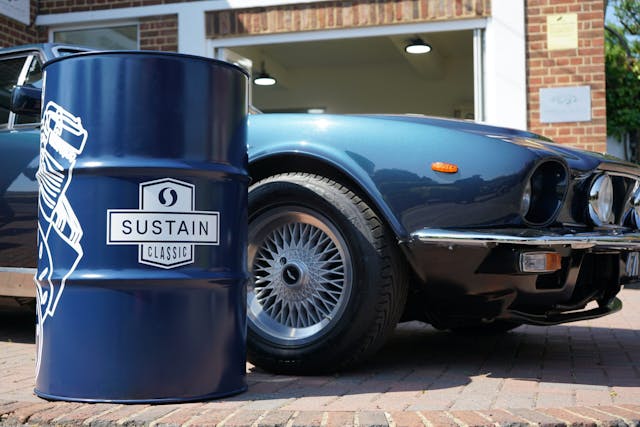First sustainable fuel is on sale, but there’s a catch
British fuel specialist Coryton is selling a range of new sustainable gasoline aimed at classic car owners, but it will be hard to come by.
Coryton Sustain Classic is available in three grades: Super 80 contains at least 80 percent renewable content, Super 33 contains 33 percent sustainable fuel and Racing 50 is made from at least 50 percent renewables. Super 80 and Super 33 are 98 RON grade, equivalent to 94 Octane, while Racing 50 is 102 RON, or 98 Octane and aimed at motorsports. In each case there is less than one percent ethanol making the fuels suitable for older vehicles.
Unlike e-fuels, which use carbon captured from the atmosphere in their manufacture, Sustain is a bio-fuel made from agricultural waste, including straw, and crops which are unfit for consumption. The theory is that the fuel only uses carbon which already exists in the atmosphere and has been absorbed by the plants as they grow. As a result Coryton claims that its Super 80 saves 65 percent of greenhouse gas emissions compared with fossil fuel, with Super 33 saving 25 percent, and Racing 50 saving 35 percent.
“The availability of true fossil-free fuel components is limited,” says David Richardson, Business Development Director at Coryton. “So, we’re setting truthful and realistic goals, producing fuels that have a meaningful impact whilst meeting the demands of the user. While we could use ‘mass balancing’ techniques to certify this fuel as 100 percent, we believe that it is important to be open about technology readiness and traceability. The industry will get there with the right support – which is why we think it’s important to start getting these products into the hands of consumers so they can see how easy and effective the switch could be.”
Coryton prices its Super 33 at £3.80 per liter, ($17.91 per gallon) Super 80 costs £4.65 per liter ($22.12), and Racing 50 is £5.24 per liter ($24.92), making it considerably more expensive than the UK average price of around £1.60 per liter ($7.60) for high octane fuel.
The bigger issue is distribution, however, as Sustain Classic is currently only available from one supplier, Motor Spirit at Bicester Heritage, near Oxford, although more retailers will be rolled out soon. Coryton says that the company is “looking to extend the product to a wider community and have already had some discussions in the U.S.”



Exactly what companies need to speak up? Complaining here is not the solution.
As for destroying our cars, there really isn’t much that needs to be done to prevent that, all new soft fuel line works fine with ethanol fuels, you can replace all your rubber fuel line in a few hours including the trip to the parts store. I have a 2005 with almost 260,000 miles on it and aside from the EVAP canister and gas cap the entire fuel system is as it was from the factory, including the factory fuel filter. This is a car that has never had less than E15 in it. The car gets good mileage but still it has had almost 9,300 gallons of E15 go through that fuel system and out the tailpipe without issue. Just for fun I have a 1993 that has 185,000 on it and 7100 gallons of E10 and E15 have gone through it and that has a fully intact 1993 fuel system.
I know you were told that things like ethanol in fuel should make you angry, because it will kill your beloved car, the reality is that it isn’t actually all that bad.
All true. But some would rather blame E15, DOT 5 silicone brake fluid (terrific stuff), multi-weight detergent motor oil– whatever it is this decade, this century — on long deferred maintenance.
Well it’s like buying carbon offset credits and just as useful. A sucker is born every minute.
Your comment is awaiting moderation.
Woke? The science of global warming is clear. Reducing carbon emissions is necessary. You harp on a company trying to provide an alternative to going all-electric (thereby preserving ICE-powered cars longer) for what reason? Yes, this fuel is currently expensive. But that is largely because it has no economy of scale at this point. And admittedly, even if it is scaled, it likely won’t be fully cost-competitive with traditional gasoline.
The problem is that the hard-headed thinking like this won’t solve the problems that need to be solved and will leave us in a situation where our outcomes and alternatives are worse than what we’d like.
Not to get into a big political bruhaha but anytime someone says something is clear and unquestionable I get to thinking they are full of something. I have spent enough time working with weather data to know that predicting tomorrow’s weather condition out to any accuracy is a bit of a guessing game, and predicting weather out 20, 50, or more years gets to be even more fuzzy. Stating you know the cause…. well… I would say for me that I am at least past the 50% point on global warming and I leave it at that. As far as fossil fuels, we will burn them until they are gone. I am 100… well 95% certain on that. Even if the world powers stop using them (for awhile), the lesser countries will step in where we left off… then we will have to get back in the game to stay economically competitive. Good luck with all this electric fun
Again….if we’re serious about a world where not just all life as well as our i.c. cars can survive, our foci is simple, if not EZ, which is why non-solutions like the above and making cars the convenient scapegoat remain:
.
According to the UN and other vetted studies, animals raised for meat and dairy produce more greenhouse gas than all the world’s cars, trucks, buses, trains, planes, ships combined.
Every poll of scientists, including 2,000 UN scientists in 2013, and 11,000 in the 11/5/19 Bloomberg News, has them agreeing that overpopulation by far our biggest problem, their words: “bigger than climate.”
Sooo, unless we want to snarl “politics,” read evermore non-solutions, continue rounding up the usual suspects: Adopt a plant-based, vegan diet, which hasn’t slowed the world’s leading Formula One driver, Lewis Hamilton, in the least. Revise our antiquated, agrarian tax codes from when more babies meant more hands to work the family farm, half of all children not surviving past age four, to instead encourage having “one or none,” and adopting.
Every nation with declining birthrate has higher per capita GNP. Since we’re on a forum sponsored by an insurance company, bear in mind health insurance public or private will never be affordable until most folks vegan.
Let the yeah buts, parsing, and equivocating begin.
Everytime I read your anti-population rants, I have to wonder if you’re either writing from an alternate timeline, or only read news stories which are 40 years out-of-date. Do you realize that birthrates around the developed world are cratering? The problem is so bad that island nations (who thus aren’t flooded with illegals from 3rd world societies) have to resort to things like this:
“…In South Korea, almost $121 billion (£99 billion) has been pumped into measures to increase the rate, establishing public daycare centres, free nurseries, as well as subsidised childcare for a child’s first year in education. In October 2019, the government announced an expansion to existing parental-leave policies and parents with children below the age of eight are now allowed to spend one less hour at work each day. Cash subsidies for parents with young children have even been expanded to include the richest 10 per cent of the population. In Singapore, parents are encouraged to have babies with cash bonuses. Prime Minister Fumio Kishida warned that Japan is “on the brink of not being able to maintain social functions”.
He said: “In thinking of the sustainability and inclusiveness of our nation’s economy and society, we place child-rearing support as our most important policy. Japan simply cannot wait any longer in solving the problem of its low birth rate.” A new government agency will be set up in April to focus on the issue…”
Throw most of developed Europe, China, Russia and North America in that same boat. Easy access to abortion, encouragement of “coupling” that doesn’t produce children, pornography addiction, fentanyl overdoes, falling rates of religious belief and maybe WWIII are all a population-phobic person’s dream come true. I’m sure all of this will reduce the demand for cows as well.
You really should be celebrating and not sound so glum.
The chamber of commerce mentality always trots out the above, catering to companies whose business model so weak it dependent on evermore customers and cheap labor. Sorry, but maybe, just maybe, all those scientists know what they’re talking about.
Calling human beings “illegals” underscores your devalue of human life. Education and contraceptives prevent the abortion you decry, so we’re hearing a bit of misogyny in your post. Meanwhile, calling something you either don’t fathom or disagree with a “rant” is bush league. You own a dictionary, or surely can consult an online one? Look up “rant.”
Sorry, Reinhold, but mom and dad’s or your grandad’s imagined “having it all” good ole days you can’t reprise.
Declining birthrate when we passed 6 billion globally October 1999, 7 billion October 2011, 8 billion last November suggests we put better brakes on this careening freight train.
Unsure how your concern over “porn addiction” and, as Bill Maher calls it, “religulousity,” nor substance abuse factors into heeding scientists. If you’re really concerned about substance abuse, according to Newsweek, TIME, US News & World Report, sugar is eight (8) times more addicting than cocaine, and a bit of judicious Googling reveals the staggering healthcare costs that’s unleashed.
A fraction of the life in the ocean, fount of all life, as in 1950. Rapidly vanishing coral reefs, rising sea levels.
But Reinhold me lad, not all of us want to live in South Dakota or Nebraska, yet do want to drive the vintage, collector, special, Edwardian, brass, ’20s30s40s, nifty ’50s, ’60s, etc. cars we’ve worked so hard on now and then on other than the halting lockstep on a concrete conveyor belt past the eyesore of mile after mile of tire shops and fast food dives; would like to preserve America the Beautiful, there already mining, lumber, drilling “access roads” in “our” national parks.
One of the tenets of adulthood, Reinhold, is being able to address hard reality, not hewing to happy talk.
Pardon the glum buzzkill, dude.
First of all kudos for venturing back inline8 (or whatever your prior user name was), as I knew you’d check to see if you had any replies. Let’s agree that a better comment platform would make this more fun.
Let’s try to stay on-topic and skip all the cutesy, prejudicial buzz-terms and notions of where you think I get my worldview. They’re sidetracks you’re using to deflect from my central point:
After peaking in the 20th Century, worldwide population will decrease.
And just as I did in my prior post, I’ll cite some sources (Since I was Asia-focused yesterday, today I’ll do Western Nations) rather than laughably pretend to be on some higher intellectual plane. (“uSe a diCtiOnaRy?! LOLZ”)
“Half of all states and nearly three quarters of all counties experienced more deaths than births in their populations between July 1, 2020, and June 30, 2021, according to U.S. Census Bureau population estimates released today.” census.gov/
“Developed countries tend to have a lower fertility rate due to lifestyle choices associated with economic affluence where mortality rates are low, birth control is easily accessible and children often can become an economic drain caused by housing, education cost and other cost involved in bringing up children. Higher education and professional careers often mean that women have children late in life… …The fertility of the population of the United States is below replacement among those native born, and above replacement among immigrant families and the socially deprived (Singh et al., 2001). However the fertility rates of immigrants to the US have been found to decrease sharply in the second generation as a result of improving education and income… …There are several factors such as lifestyle factors, an increase in sexually transmitted diseases, rise in obesity and environmental factors involved in urbanisation and urban lifestyle that are affecting fertility and have led to rise in male and female subfertility… …In parallel, it is also necessary to have a national and an international initiative for the prevention of infertility and protection of fertility.” ncbi.nlm.nih.gov/
(BTW, they can call it “urbanisation and urban lifestyle”, but I’m willing to say “same-sex, abortion, porn, drugs, social awkwardness & humanism”.)
So my point remains the same. You’re getting what you want; a reduction in consumers of resources. Research shows this to be true enough that after years of preaching about population bombs, our ever more capitalistic, ever more affluent, ever more urban society eventually reaches the peak of a bell curve regarding population. And they’ll take the need (profit) for livestock with them!
Worldwide population is decreasing because of better education and woman’s rights. Child bearing is being deferred. Also, fertility rates are going down, possibly because of plastic pollution. All those nasty chemicals. If you want to blame someone, then unregulated capitalism stands out.
Absolutely, Monsignor Cox. As in awake. Tho’ some of us guilty of being un-PC now and then, better awake, attuned, as Tim and Don Cox observe, than momentarily removing head from the Fox ‘n’ tawk radio sand now and then long enough to snarl at the latest effort to make what’s left of this ravaged, overpopulation planet livable, healthier.
I flew a company as a corporate pilot once that made ethanol. When I asked why they would consider building a plant in Wyoming, far from their corn base stock, they said that it was closer to the coal they needed so one way or another they were shipping something.
How much energy does it take to turn bio-waste into fuel? Ethanol is a shell game, it takes massive amounts of fossil fuel to make it.
Absolutely. Even Al Gore admits making ethanol from corn, not agwaste, as Brazil– and Henry Ford– intended, a boondoggle. Ford’s Model T and Fordson tractor by 1920 comprised fully half of all cars and tractors on the world’s roads and fields, both intended to run on agwaste ethanol. But John D. Rockefeller controlled 85-90 % of all bulk oil shipments in the nation, so with gas prices as low as a dime or 12 cents a gallon, infrastructure in place. Ford went along with the program rather than agwaste ethanol, as would’ve the Dodge Brothers, Hudson, Auburn, Charlie Nash, Walter P. Chrysler/Buick, REO, Studebaker, Pierce, Packard, Willys, Elcar, Gardner, William Crapo Durant, Locomobile; most of the industry.
Not that they’re angels, but Brazil is the only major nation not to have been at war in the past two centuries.
Ok..Where is the “Top End Lubricant” in this sustainable fuel? Paying for it…in the pocket way…..